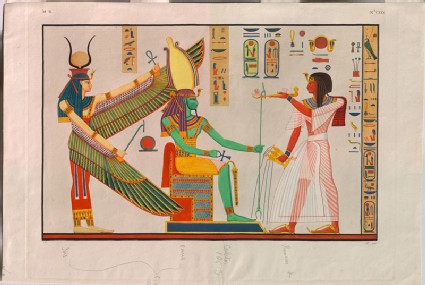Browse: 1470 objects
Engraving of a Painting of Ramesses III adoring Isis and Ptah-Sokar, from Ramesses' Tomb at Biban el-Moluk Anonymous Italian
-
Curator’s description:
Description
The engraving shows three figures: on the left, the winged goddess Isis; in the centre, enthroned, the god Ptah-Sokar with the attributes of Osiris; and on the right, the pharaoh Ramesses III (reigned c.1187-c.1156 BC). It reproduces a painting in Ramesses' tomb at Biban el-Moluk (the Valley of the Kings) (Porter & Moss, "Topographical Bibliography", 2nd ed, Oxford (Clarendon Press & Griffith Institute): 1960-1999, vol. I, pt 2, p. 523).
The print is taken from the first volume of plates from Ippolito Rosellini's "Monumenti dell' Egitto e della Nubia", published in 1832. It was first catalogued by Ruskin in the "Catalogue of Examples" of 1870, as no. 105 in the Standard Series; in the 1872 catalogue of the Standard and Reference Series, it was renumbered as no. 180 in the Reference Series. It was placed alongside other plates from Rosellini.
Neither the draughtsman, named as 'Cb', nor the engraver, named as 'M', can be identified with certainty.
According to Cook and Wedderburn (XX.399 n.1), this is the plate Ruskin referred to as 'Rosellini's plate of Rameses adoring the sun power under the hawk symbol' in "The Eagle of Elis", his planned continuation to "Aratra Pentelici" (§ 4 = XX.399).
In a note in "The Ethics of the Dust", explaining how the individual aspects of the Egyptian deities were still largely unknown, Ruskin was somewhat sceptical of Rosellini's qualities: 'for the full titles and utterances of the gods, Rosellini is as yet the only - and I believe, still a very questionable - authority' (Ethics of the Dust, note III = XVIII.363). In his entry below nos 176-180 in the Reference Series, Ruskin again questioned Rosellini's accuracy, noting that the colours were sometimes conjectural, 'slight traces of the original pigments, and those changed by time, being interpreted often too arbitrarily' (Standard and Reference Series catalogue, p. 22).
In the section of "Aratra Pentelici" which expanded upon his lecture on "Imagination" of 26 November 1870, Ruskin was more interested in the relationship between sculpture and polychromy, noting that 'all the early sculpture of the most accomplished nations has been thus coloured' and that, as soon as colour was applied within a scratched outline, 'the colouring soon becomes a principal means of effect, so that, in the engraving of an Egyptian-colour bas-relief (S. 101 [now Reference Series no. 176]), Rosellini has been content to miss the outlining incisions altogether, and represent it as a painting only' (Aratra Pentelici, § 32 = XX.222)
-
Details
- Artist/maker
-
Anonymous Italian (Anonymous, Italian) (artist, engraver)
- Object type
- Material and technique
- watercolour and bodycolour over etching and engraving in red and black ink on wove paper
- Dimensions
- 341 x 532 mm (plate); 443 x 663 mm (sheet)
- Associated place
-
- Africa › Egypt › Qinā › Biban el-Moluk › Tomb of Ramesses III › Tomb of Ramesses III (subject)
- Inscription
- Recto, engraved:
top left: M.R.
top right: No. CXLV
bottom left: Cb. [?]
bottom right: M. scul.
Recto, manuscript, below the image, all written down the page in graphite in the same hand:
right of centre: Rameses 4.
centre: Cubito. [?] | 106.3
just to the left: Osiris
left: Isis. [the latter two inscriptions bracketed together with a long brace which points to:] 5.10[...] | 10[...]
Verso, bottom centre, the Ruskin School's stamp
- Provenance
-
Presented by John Ruskin to the Ruskin Drawing School (University of Oxford), 1875; transferred from the Ruskin Drawing School to the Ashmolean Museum, c.1949.
- No. of items
- 1
- Accession no.
- WA.RS.REF.180
-
Subject terms allocated by curators:
Subjects
-
References in which this object is cited include:
References
Ruskin, John, Catalogue of Examples Arranged for Elementary Study in the University Galleries (Oxford: Clarendon Press, 1870), cat. Standard no. 105
Rosellini, Ippolito, I monumenti dell' Egitto e della Nubia: Disegnati dalla spedizione scientifico-letteraria toscana in Egitto: distributi in ordine di materie, 12 (Pisa: Presso N. Capurro, 1832-1844), pt I, Tavole, pl. CXLV
Ruskin, John, Catalogue of the Reference Series Including Temporarily the First Section of the Standard Series (London: Smith, Elder, [1872]), cat. Reference no. 180
Ruskin, John, ‘The Ruskin Art Collection at Oxford: Catalogues, Notes and Instructions’, Edward T. Cook and Alexander Wedderburn, eds, The Works of John Ruskin: Library Edition, 39 (London: George Allen, 1903-1912), 21, cat. Reference no. 180
Ruskin, John, ‘The Eagle of Elis’, Edward T. Cook and Alexander Wedderburn, eds, The Works of John Ruskin: Library Edition, 39 (London: George Allen, 1903-1912), 20
Location
-
- Western Art Print Room
Position in Ruskin’s Collection
Ruskin's Catalogues
-
Ruskin's Catalogue of Examples (1870)
105. Rameses IV adoring Isis and Osiris. Rosellini, Tavole, tom. i. pl. 145. Text, tom. v. p.104. -
Ruskin's Standard & Reference series (1872)
180. Rameses IV. adoring Isis and Osiris. Rosellini, Tavole, tom. i. pl. 145. Text, tom. v. p. 104.





